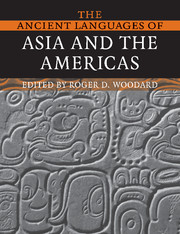Book contents
- Frontmatter
- Contents
- List of figures
- List of tables
- List of maps
- List of contributors
- Notes on numbering and cross-referencing
- List of abbreviations
- Preface
- Preface to the first edition
- 1 Language in ancient Asia and the Americas: an introduction
- 2 Sanskrit
- 3 Middle Indic
- 4 Old Tamil
- 5 Old Persian
- 6 Avestan
- 7 Pahlavi
- 8 Ancient Chinese
- 9 Mayan
- 10 Epi-Olmec
- Appendix 1 Reconstructed ancient languages
- Appendix 2 Full tables of contents from The Cambridge Encyclopedia of the World's Ancient Languages, and from the other volumes in the paperback series
- Index of general subjects
- Index of grammar and linguistics
- Index of languages
- Index of named linguistic laws and principles
2 - Sanskrit
Published online by Cambridge University Press: 01 September 2010
- Frontmatter
- Contents
- List of figures
- List of tables
- List of maps
- List of contributors
- Notes on numbering and cross-referencing
- List of abbreviations
- Preface
- Preface to the first edition
- 1 Language in ancient Asia and the Americas: an introduction
- 2 Sanskrit
- 3 Middle Indic
- 4 Old Tamil
- 5 Old Persian
- 6 Avestan
- 7 Pahlavi
- 8 Ancient Chinese
- 9 Mayan
- 10 Epi-Olmec
- Appendix 1 Reconstructed ancient languages
- Appendix 2 Full tables of contents from The Cambridge Encyclopedia of the World's Ancient Languages, and from the other volumes in the paperback series
- Index of general subjects
- Index of grammar and linguistics
- Index of languages
- Index of named linguistic laws and principles
Summary
HISTORICAL AND CULTURAL CONTEXTS
Sanskrit is an Indo-European language, a member of the Indo-Aryan branch of the Indo-Iranian subgroup of that family. It is chronologically and in terms of linguistic development the “oldest” Indo-Aryan language and consequently often referred to as Old Indic (Altindisch) or Old Indo-Aryan; its descendants include a range of linguistic varieties classified under the rubric Middle Indic (or Prākrit, see Ch. 3), as well as the Modern Indic (New Indo-Aryan) languages spoken today, such as Hindi, Gujarati, Bengali. It is not related genetically to the Dravidian languages of South India, such as Tamil and Telegu.
The oldest form of Sanskrit is so-called Vedic Sanskrit, the language of the four collections of liturgical texts known as the Vedas and of the early exegetical literature on these texts. The oldest Veda is the Ṛgveda (Rig-veda), a compilation of 1,028 hymns which took shape around 1500 BC in northwest India, though the composition and collection of hymns clearly occupied several centuries. In language, style, and phraseology the Ṛgveda resembles the earliest texts of its closest linguistic relative, the Gāthās attributed to the prophet Zarathustra, composed in Old Avestan (see Ch. 6).
Though the composition of Vedic texts can be dated with fair confidence to the period of c. 1500–500 BC, direct records of them are only found several millennia later. The “texts” were transmitted orally, with minimal alteration, and even after they were also committed to writing, the manuscripts were perishable and less reliable than the oral tradition.
- Type
- Chapter
- Information
- The Ancient Languages of Asia and the Americas , pp. 6 - 32Publisher: Cambridge University PressPrint publication year: 2008
- 1
- Cited by

